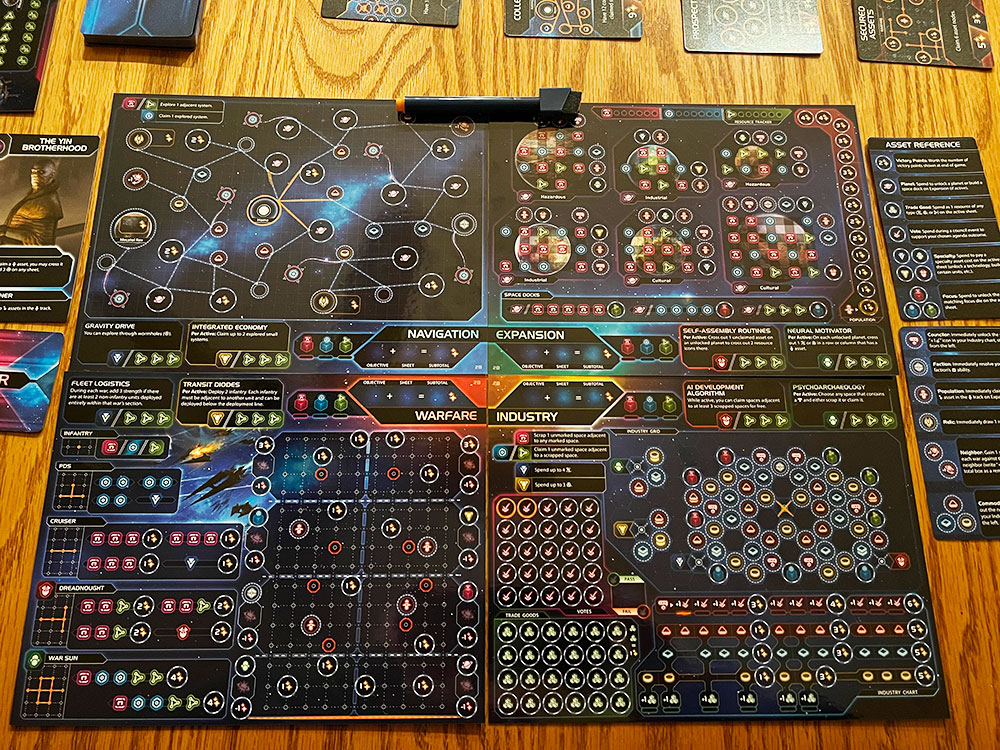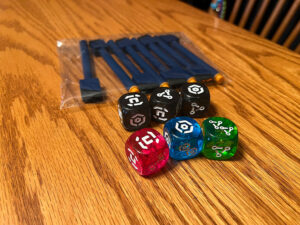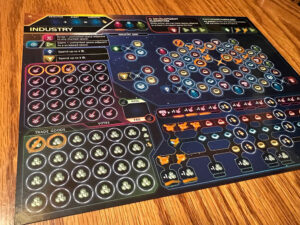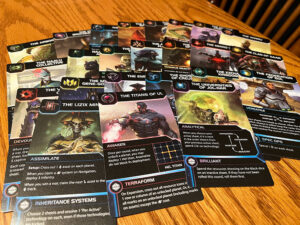 I have always wanted to play Twilight Imperium, but the high player count, complexity, and most importantly, game length, prevented me from doing so. Well, at least until Fantasy Flight Games announced a new game premiering at Gen Con 2022. A much more streamlined version of their flagship IP called Twilight Inscription? Sign me up!! Wait… it’s a roll and write? And it still takes two hours? Seriously??
I have always wanted to play Twilight Imperium, but the high player count, complexity, and most importantly, game length, prevented me from doing so. Well, at least until Fantasy Flight Games announced a new game premiering at Gen Con 2022. A much more streamlined version of their flagship IP called Twilight Inscription? Sign me up!! Wait… it’s a roll and write? And it still takes two hours? Seriously??
Regardless of my roller coaster of emotions concerning the game’s announcement, I was lucky enough to be able to demo it at Gen Con 2022 with several other BGQ contributors. It was a well-run demo that did exactly what demos are supposed to do—provide both an overview of the game and just enough gameplay to decide if you will enjoy the game. To be honest, I really enjoyed the game, but was unable to acquire it due to the limited quantities available at Gen Con. The world moved on.
Fast forward six months and I am lucky enough to have a review copy in my hands. Now that I have the full game, will I enjoy it as much as I did in the convention? Or did the over-oxygenated convention center impact my ability to accurately judge the demo?
Gameplay Overview:
Twilight Inscription is a competitive roll and write for one to eight players, with games lasting between 90 and 180 minutes, depending on the number of players and their knowledge of the game.
Players choose from one of 24 unique Factions and try to dominate the galaxy over several events (rounds) that are drawn from the Event Deck. Each round starts with an event being revealed. How the round is played depends on which of the four event types was revealed:
• Strategy (most common) – players do the following:
- Pick one of their four (yes, four) sheets to be the active sheet for this round. The four sheets are: Navigation – explore the galaxy, Expansion – take assets and population from planets (think the RDA in Avatar), Industry – invest in the Faction’s infrastructure, Warfare – expand your Faction’s military forces.
- Strategy Events provide resources on the card – spend these on your active sheet.
- Six dice (three black, three focus dice) are rolled, providing more resources for the round. The resources from the three black dice, as well as any focus dice unlocked from technologies earned in previous rounds, are spent on the active sheet.
• Warfare (four events during the game): Compare the left side of your armada’s strength to the neighbor on your left and do the same to the neighbor on your right (this is handled using simple AI for two player or solo). The winner gets a bonus and the loser gets a penalty.
• Production (three events during the game): Players claim trade goods based on how advanced their Industry is – yep, it’s that fast and that easy.
• Council event (three events during the game):
- An agenda card is read aloud.
- Votes are cast by spending a vote asset for each vote cast (also handled via a simple AI for two player or solo games).
- Votes are announced.
- The agenda is resolved based on if it passed or failed.
Depending on how the Event Deck was randomized, the game ends on either the 23rd or 25th event. The player with the most points has officially dominated the galaxy! Congratulations!

Game Experience:
I have always enjoyed roll and writes, but Hadrian’s Wall made me fall in love with them. It was so much more complicated (in a good way) in terms of choices and depth. When I saw Twilight Inscription, my eyes bulged like I was in a cartoon. It had FOUR sheets to mark off (Hadrian’s Wall only had two). It also promised more direct interaction.
What made me want to leave Earth and dominate the galaxy
Twilight Inscription provides choices in spades. The four active sheets are their own mini game but are still interconnected. Navigation has you spending resources to either explore adjacent systems or claim assets on explored systems on a galactic map. Planets claimed on the Navigation sheet allow you to explore them on the Expansion sheet, where you try to complete rows and columns on different planet types to unlock assets. Assets found on Expansion will improve your Industry, unlocking trade goods and votes (more on these later). The Industry minigame has you starting out in the center of many nodes that are grouped together. You must either claim a node to unlock its asset or scrap a node so that you can move farther out in the grouping. Why would you scrap a node? Because you cannot claim a node unless it is adjacent to a scrapped node. Sidebar – I have never used the word node more in a paragraph in my lifetime.
The final sheet is Warfare, where you spend resources to build one of four ship types or infantry, each of which has its own shape. When completed, the shape is drawn on a grid that will potentially unlock assets while simultaneously increasing your military strength for the inevitable war(s) ahead.

As you can see, during strategy events it is not as simple as “I’ll activate Expansion.” Ok, TECHNICALLY it is that simple; however, since the event card is revealed BEFORE choosing your active sheet, you know what resources are being provided by the event. As it may be more beneficial for you to spend the resources on one sheet versus the other three.
The choices continue with the number of assets available in the game. There are 12 different assets to unlock, with some having multiple types. While some assets have an immediate effect, others are saved to be spent later. This is what drives the choices and the fun combos in Twilight Inscription. Trade goods are an example of assets that can be spent. They can count as any of the three resource types provided by the strategy card and the dice and can be spent during any strategy event. This really opens your decision space as spending a trade good on Expansion might complete a row on a planet, earning you a commodity that is immediately added to Industry, earning you ANOTHER trade good that you can spend to extend your turn or save for another round. I really love the combo potential in Twilight Inscription!
The Factions also impact the choices you make during the game. At the start of the game, you are given three factions from which pick one. Each faction has two types of abilities:
• Active ability – triggered based on the requirements on the card.
• Faction ability – triggered when you unlock a Faction asset.

The abilities are varied and, I assume, are thematic to the Twilight Imperium universe. The back of each card briefly explains the Faction’s history. I really liked the inclusion of the Factions as it provides more replay value as each Faction plays differently and will influence your strategies during the game.
The last impact on choice are the dice. Every strategy round is different based on the card drawn and how the dice are rolled. While you will know the resources you will receive from the event before choosing your active sheet, you will not know the result of the die roll until after. In addition, the focus dice can be unlocked on each sheet. For example, if you unlocked the blue die on the Expansion sheet, every time you make Expansion active, you will get the resources from the three black dice and the blue die. As you can see, the randomness of the dice and unlocking of focus dice will really impact how each turn is played and may have you rethinking your short-term strategy round by round.
There is more that I enjoyed but cannot go into more detail due to word-count restraints:
• The 32 sheets included in Twilight Inscription are double sided – one side is the same for every player and the other is asymmetrical.
• Public objectives for each sheet that are randomly selected at the start of the game.
• Eighteen relics (one of the 12 asset types) that can be earned during the game.
• The race for claiming Mecatol Rex, the center of the Galactic Council, on Navigation.
• The Play as you Learn guide included really assisted in teaching the game.
What made me wish I was playing Hadrian’s Wall
There are three reasons I did not sell Hadrian’s Wall after playing Twilight Inscription.

First, I wish the events were more random. The deck is set up by dividing the cards into ten piles, five stages then blue or black cards for each of the five stages. These ten piles are shuffled individually, then you build the deck alternating between a black and a blue card from stage five, the stage four, etc. until the deck is ready. There are no extra event cards. You will see the same events every game, just in a semi-random order. This really gives an advantage to players with experience versus those that are new to the game. Also, SOME variability in events would be appreciated.
Second, the interaction from the Warfare and Council events are not very deep. The Warfare event is just like 7 Wonders—compare the strength of your armada to your neighbor’s strength and determine the winner. I wish it had more depth like being to eliminate your opponent’s ships if you drew a certain formation or special abilities on the Faction sheets. As for the Council phase, you simply spend votes on the outcome you want to have happen. There is no trading. I suppose you could promise to not do something on Warfare in exchange for votes, but that would be the extent of your ability to negotiate. Again, I wish these events were more robust.
Finally, I have concern with long-term usage of the chalk markers included in the game. If you consistently play two-, three- or four-player games it will not be an issue compared to those who play at higher player counts, but you will have to buy replacement markers eventually and they are more expensive than pencils.
Final Thoughts:
I really enjoyed Twilight Inscription. It did not replace Hadrian’s Wall; however, owning Hadrian’s Wall should not prevent you from at least trying, if not buying, Twilight Inscription. It is an excellent roll and write. If you enjoy unlocking multiple items through combos, then this is the roll and write for you. The asymmetrical Factions and sheets only increase the replay value of a game that, outside of events, already had plenty of replay value. The interaction, while light, is the cherry on top. Finally, I enjoyed the theme of the game as I am a sucker for sci fi. I highly recommend Twilight Inscription, especially if you like roll and writes.
Final Score: 4 Stars – A unique game that offers direct interaction and the most choices (so far) in roll and write history.

Hits:
• Four-sheet system
• Combos and unlocking assets
• Dice system
• Twenty-four unique Factions
Misses:
• Event system could have been more random
• Interaction was not as in depth as I had hoped
• Long term use of chalk markers






















Most boring game ever. Some designer actually though that doing homework is fun.